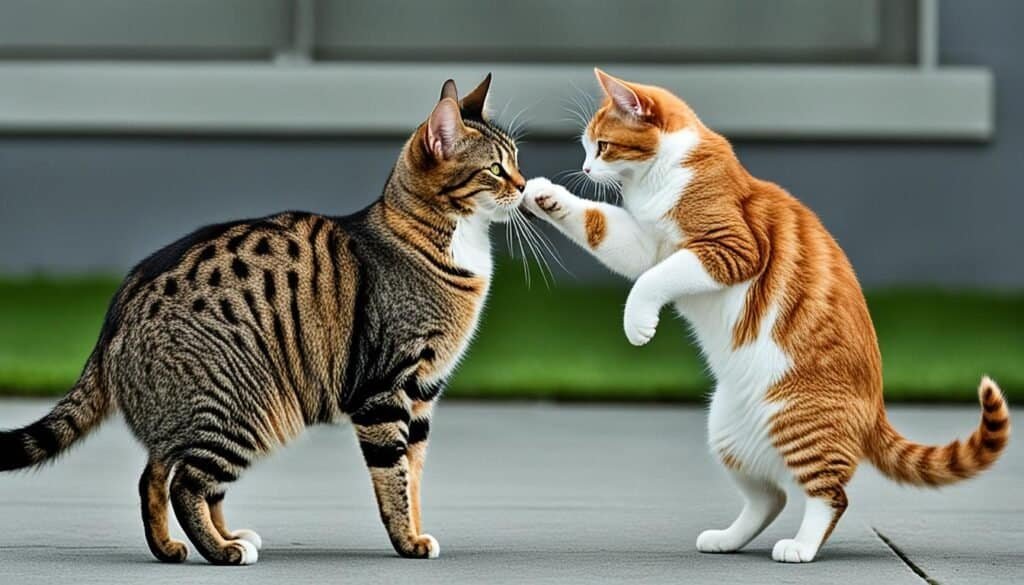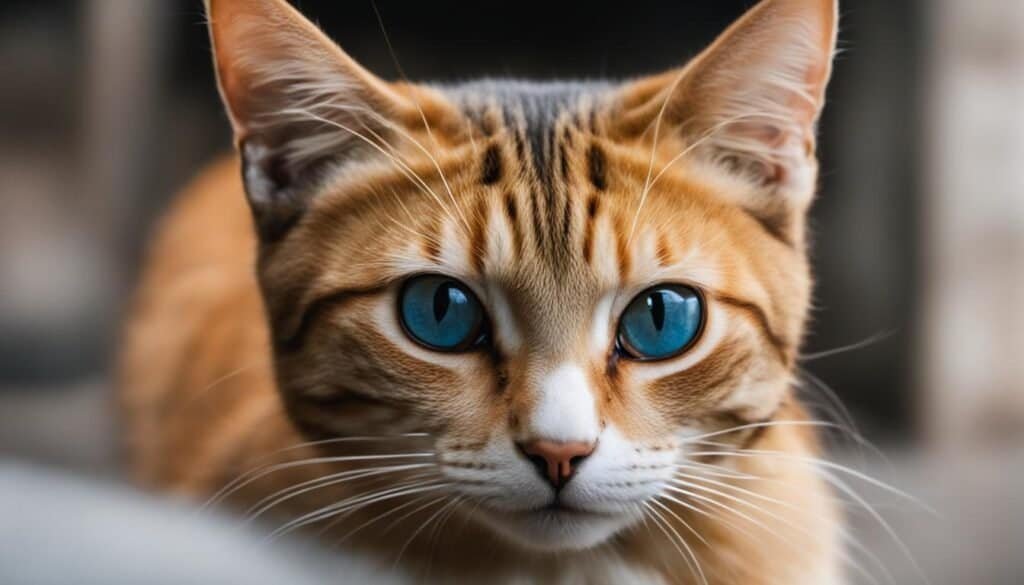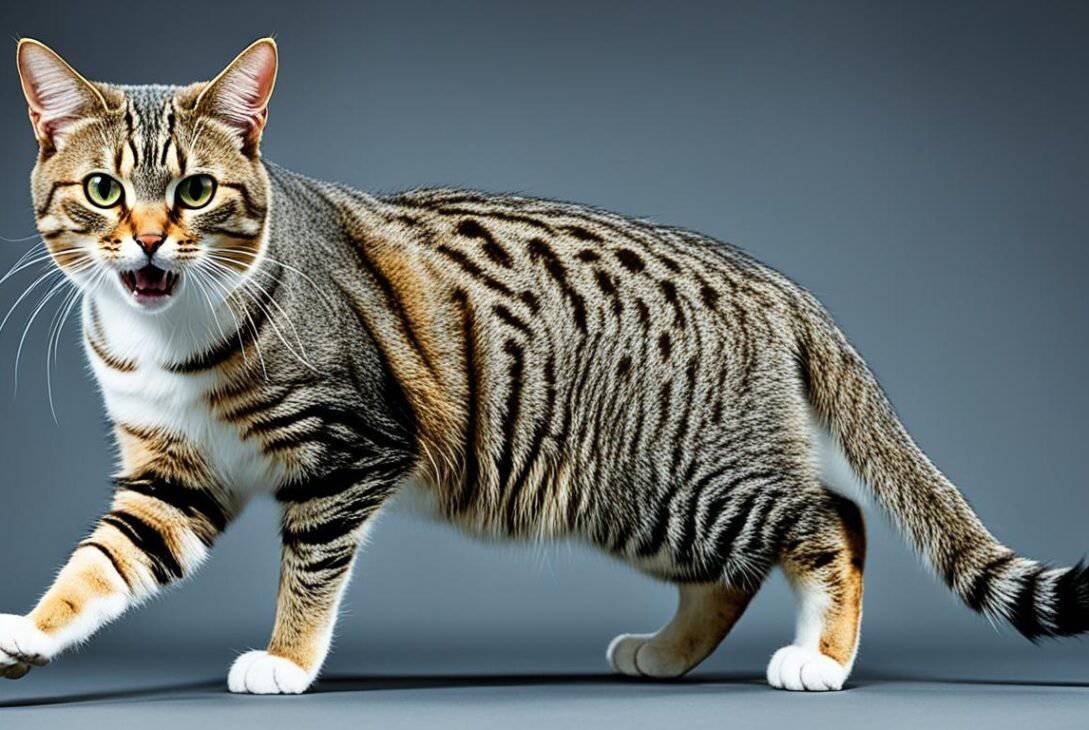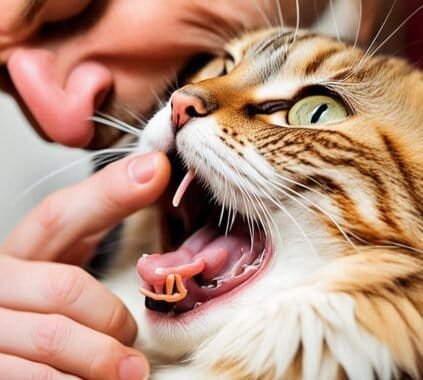Aggression is a common issue that many cat owners face, and it can be both frustrating and concerning. Whether it’s hissing, scratching, or outright attacks, aggressive cat behavior can create an unsafe and stressful environment for both cats and their human companions. It’s essential to understand the causes of cat aggression to effectively address this behavior and promote a peaceful coexistence.
Aggression is the second most common feline behavior problem seen by animal behaviorists. Cats have the potential to inflict harm with their sharp teeth and claws, making it crucial to address aggressive behavior promptly and appropriately. By gaining a deeper understanding of aggression and its underlying causes, cat owners can take the necessary steps to prevent and resolve this issue.
Key Takeaways:
- Aggression is a common feline behavior problem that requires attention.
- Cat aggression can pose a threat to both cats and humans.
- Gaining an understanding of the causes of aggression is essential in addressing and resolving the issue.
- Creating a safe and peaceful environment for cats involves implementing appropriate interventions.
- The well-being and safety of both cats and humans rely on effective management of aggressive cat behavior.
What Is Aggression?
Aggression is a common behavior displayed by cats when they feel threatened or want to defend their territory. It can manifest in various forms and intensities, ranging from mild hissing or avoidance to full-on attacks. Understanding the different types of aggression and their triggers is crucial for addressing and managing this behavior.
Cats may exhibit aggressive behavior towards humans, other cats, or animals, depending on the circumstances. Aggression can be defensive, territorial, or even play-related. It is essential to recognize the signs of aggression and take appropriate measures to ensure the safety of both humans and cats.
“Aggression is threatening or harmful behavior directed toward a person, another cat, or other animals.”
Identifying the causes of aggression is essential in developing effective solutions. Cats can become aggressive due to fear, pain, frustration, or a lack of socialization. In some cases, medical conditions can also contribute to aggressive behavior, so it is crucial to consult a veterinarian to rule out any underlying health issues.
Types of Aggression
1. Territorial Aggression: Cats are territorial by nature and may exhibit aggression to protect their territory from intruders, whether they are other cats, dogs, or humans.
2. Defensive Aggression: Cats may display defensive aggression when they feel threatened or cornered. This form of aggression is often accompanied by defensive body language, such as a flattened ears, hissing, or spitting.
3. Play Aggression: Kittens and young cats may show play aggression during playtime. While this behavior is normal, it should be redirected towards appropriate toys and discouraged when it becomes too rough.
4. Redirected Aggression: Cats can sometimes redirect their aggression towards nearby individuals, including humans and other cats, when they are unable to direct it at the original source of stress or agitation.
5. Petting-Induced Aggression: Some cats may become aggressive during petting sessions, especially when overstimulated. It is important to pay attention to a cat’s body language and provide them with space when they show signs of discomfort.
By understanding the reasons behind aggressive behavior, cat owners can implement appropriate techniques to manage and prevent aggressive incidents. Creating a peaceful and safe environment for both cats and humans is achievable with patience, proper socialization, and seeking professional advice when necessary.
Understanding Cat Body Language
Cats are masters of non-verbal communication, expressing their emotions and intentions through body language. Understanding cat body language is key to deciphering their needs, moods, and potential behavioral issues like aggression.
Cat body language can be subtle and nuanced, making it more challenging for humans to interpret compared to dogs. By paying attention to their postures, facial expressions, and the position of their ears, tail, and whiskers, cat owners can gain valuable insights into their feline companions.
- Postures: Cats use different postures to convey their emotions. For example, an arched back and bristled fur indicate fear or aggression, while a relaxed and stretched-out position typically signifies contentment.
- Facial Expressions: Staring eyes, dilated pupils, and flattened ears may suggest fear or aggression, while half-closed eyes and slow blinking often indicate relaxation and trust.
- Ears: Forward-facing ears show interest, while flattened or backward-facing ears indicate fear or aggression.
- Tail: A thrashing or bushy tail usually signals annoyance or aggression, while a relaxed and gently swaying tail indicates contentment.
- Whiskers: Extended whiskers point forward when a cat is curious or focused, and pulled back against the face when feeling threatened.
By familiarizing themselves with these basic postures, cat owners can develop a deeper understanding of their cat’s emotional state and respond appropriately. This awareness becomes especially crucial when addressing aggressive cat behavior.
“Cat body language is a fascinating and complex form of communication. It requires patience and observation to fully comprehend what our feline companions are telling us.” – Dr. Emily Williams, Feline Behavior Specialist
By recognizing the subtle cues and signals conveyed through cat body language, owners can better predict and address episodes of aggressive behavior in their cats. Understanding the root cause and interpreting their cat’s emotions will enable owners to provide appropriate interventions and create a harmonious environment for their furry companions.
Offensive and Defensive Postures
When it comes to feline aggression, cats communicate their intentions through offensive and defensive postures. Understanding these postures is crucial for cat owners in order to identify potential threats and prevent aggressive incidents.
Offensive postures are often displayed when a cat feels threatened or wants to assert dominance. These postures include a stiff stance, stiffened rear legs, direct stare, and growling. The cat may also expose its teeth or claws as a warning sign. It is important for cat owners to recognize these offensive postures and avoid touching or punishing the cat in these situations.
Defensive postures, on the other hand, are manifested when a cat feels the need to protect itself. These postures usually involve crouching, tucking the tail close to the body, and flattening the ears. When a cat assumes these defensive postures, it indicates that the cat feels cornered or threatened and may act aggressively to defend itself. It is vital to give the cat space and not force interaction in these situations to prevent further escalation of aggression.
To better understand offensive and defensive postures in feline aggression, observe the following:
- A cat with offensive postures: A cat stands still with a stiff body, its tail raised and held still, and its ears pointed forward. The cat directly stares at the perceived threat with dilated pupils, growling or hissing as a warning.
- A cat with defensive postures: A cat crouches low to the ground, folding its body close to the floor. The ears are flattened against the head, the whiskers are pulled back, and the tail is tucked between the hind legs. The cat may hiss or make spitting sounds to show its fear.
Recognizing and respecting offensive and defensive postures is key to preventing cat aggression and maintaining a peaceful environment for both cats and their human companions.

Classification of Aggressive Behavior
Understanding the different types and causes of aggressive behavior in cats is essential for effective intervention and management. Aggression in cats can be classified based on its function or purpose, allowing us to identify the underlying motivations behind the behavior.
One common cause of aggressive behavior in cats is medical conditions. Pain, discomfort, or underlying health issues can contribute to aggression. Therefore, it is crucial to have your cat thoroughly examined by a veterinarian to rule out any medical causes.
Additionally, aggressive behavior can be categorized as offensive or defensive. Offensive aggression includes signs of intimidation such as a stiff stance, growling, and direct eye contact. Defensive aggression, on the other hand, involves defensive postures like crouching, flattened ears, and a tucked tail.
In some cases, aggression may be the result of fear or insecurity. Fearful cats may display defensive aggression to protect themselves when they perceive a threat. Understanding the triggers and avoiding them can help minimize fear-based aggression.
Redirected aggression is another type that occurs when a cat is unable to directly respond to a stimulus. The frustration from being unable to confront the source of arousal can result in aggression towards other cats or humans.
It is important to note that each case of aggression is unique, and determining the cause and appropriate intervention requires careful observation and consultation with professionals.
“Properly identifying the type of aggression is crucial in implementing appropriate strategies to address the issue and ensure the well-being of both the cat and its human companions.”
To better understand this classification, let’s take a closer look at each type of aggression and their characteristics:
Offensive Aggression
- Stiff stance
- Stiffened rear legs
- Direct stare
- Growling or hissing
Defensive Aggression
- Crouching
- Tucked tail
- Flattened ears
- Quick swipes with claws
Fear Aggression
- Hissing
- Spitting
- Piloerection (raised fur)
- Growling
Redirected Aggression
- Sudden and intense aggression
- Triggered by a separate stimulus
- Targeted towards other cats or humans
Understanding the classification of aggressive behavior in cats is an important step towards implementing effective strategies to manage and mitigate aggressive tendencies. Remember, each cat is unique, and a tailored approach based on their specific behavior is crucial.
Now, let’s delve into the complexities of aggression between cats in Section 6.
Aggression Between Cats
Aggression between cats, whether in unneutered males or household companions, can be a complex issue with various underlying factors. One common cause of aggression between unneutered male cats is territorial disputes. As these cats strive to establish dominance and protect their territory, conflicts may arise, leading to aggressive encounters and cat fights.
When it comes to aggression between household cats, the dynamics can be more subtle and intricate. Physical size, lack of social experiences, and accidental association with unpleasant events can all contribute to aggressive behavior. These circumstances may result in personality clashes or territorial clashes, where cats vie for control over their shared space.
Managing aggression between cats requires understanding the underlying causes and implementing appropriate interventions. It’s important to create a peaceful environment by providing sufficient resources, such as separate feeding areas, litter boxes, and resting spots for each cat. Finding ways to ensure socialization and positive interactions between cats can also help alleviate tension and reduce aggression.
To address aggression between cats, cat owners can gradually introduce two or more cats to each other, allowing them to get acquainted at their own pace. This process helps establish familiarity and build positive associations. Additionally, creating vertical spaces, such as cat trees or shelves, allows cats to claim their territory and reduces the likelihood of confrontations.
Remember, aggression between cats can be distressing for both the cats involved and their owners. Seeking guidance from a veterinarian or animal behaviorist is essential in developing a customized plan to address the aggression and create a harmonious home environment for everyone.
Common Causes of Aggression Between Cats:
- Territorial disputes
- Lack of social experiences
- Accidental association with unpleasant events
“Cats strive to establish dominance and protect their territory, often leading to aggressive encounters and cat fights.”
Fearful or Defensive Aggression
Fear aggression is a common behavior problem observed in cats. When a cat perceives a threat, it may respond with a combination of defensive and aggressive signals. Common signs of fear aggression include hissing, spitting, piloerection (raised fur), and growling.
Cats exhibiting fear aggression are typically feeling cornered or trapped and are acting out of self-defense. It is important to understand that the aggression stems from fear and should not be interpreted as malicious intent.
If you encounter a fearfully aggressive cat, the best approach is to avoid the perceived threat and minimize interactions until the cat calms down. Creating a safe environment by providing hiding spots or separate spaces can help the cat feel more secure.
It is crucial not to punish or physically restrain a fearfully aggressive cat as it may worsen the fear response and potentially escalate the aggression. Seeking professional help from a veterinarian or animal behaviorist is recommended to develop an appropriate behavior modification plan for the cat.
“Fear aggression in cats is often a survival strategy triggered in response to perceived threats. Patience, understanding, and creating a secure environment are key to helping a fearfully aggressive cat.”

Territorial Aggression
Cats are territorial by nature and may display aggression to defend their territory. This territorial aggression can be directed towards other cats, dogs, or humans. When cats feel their territory is being threatened, they may exhibit various aggressive behaviors as a means of protecting what they perceive as their own.
Cats have several ways of marking their territory. They may patrol the boundaries of their territory, leaving visual and olfactory marks through rubbing their chins against objects and spraying urine. These marks serve as a warning to potential intruders, indicating that the area is already claimed.
Major changes in the household can trigger territorial aggression in cats. This could include the introduction of a new pet or a new baby, rearranging furniture, or moving to a new home. These changes disrupt the familiar environment, causing the cat to feel threatened and prompting territorial aggression as a response.
Additionally, the presence of intruders, such as outdoor cats or stray animals, can trigger territorial aggression. When cats sense another animal in their territory, they may become defensive and aggressive in an attempt to protect their territory from potential threats.
To address territorial aggression in cats, it is important to create a secure and stable environment. Providing ample resources, such as litter boxes, food bowls, and resting areas, ensures that cats feel confident in their territory. Using positive reinforcement techniques and redirecting aggressive behaviors towards appropriate outlets, such as interactive toys, can help alleviate territorial aggression and promote more peaceful interactions.
Play Aggression
Play aggression is a common behavior among kittens and young cats. During play, cats can exhibit behaviors such as biting, scratching, and pouncing. While this behavior is normal, it is important for owners to understand how to handle aggressive play in order to maintain a safe and enjoyable environment for both the cat and the owner.
Proper socialization during kittenhood plays a crucial role in teaching cats to inhibit their aggressive play. By providing them with opportunities for play and interaction from a young age, cats can develop appropriate play skills and learn boundaries.
Owners should avoid encouraging play aggression with their hands and feet as this can reinforce the behavior and lead to more intense aggression in the future. Instead, it is important to redirect the cat’s play to appropriate toys, such as interactive wands or puzzle toys. These toys not only provide an outlet for the cat’s energy but also help channel their natural hunting instincts in a positive way.
Additionally, it is important to set clear boundaries during playtime. If the cat becomes too rough or aggressive, gently and calmly disengage from the play session and give the cat some time to calm down. This teaches the cat that aggressive play does not result in continued attention and playtime.
By understanding and properly managing play aggression, owners can ensure a harmonious and enjoyable relationship with their feline companions.
Redirected Aggression
Redirected aggression is a common phenomenon in cats that can lead to aggressive behavior towards other cats or humans. It occurs when a cat is stimulated or aroused by a specific stimulus but is unable to directly respond to it. In this state of heightened arousal, the cat may redirect its aggression towards a different target that is within reach.
Common triggers for redirected aggression include loud noises, unexpected disturbances, or the presence of a rival cat. For example, if a cat sees a rival cat outside the window and becomes agitated and frustrated by its presence, it may redirect its aggression towards another cat or human that happens to be nearby.
To prevent further attacks, it is crucial to remove or avoid the stimuli that trigger the redirected aggression. This can involve creating a calm and secure environment for the cat, minimizing exposure to potential triggers, and providing appropriate outlets for energy and stimulation.
Redirected aggression is not a reflection of the cat’s character or personality but rather a response to a specific situation. It is important for cat owners to understand this behavior and approach it with patience and understanding. Seek advice from a veterinarian or animal behaviorist to develop a comprehensive plan for managing redirected aggression in your cat.
“Redirected aggression is a complex behavior that can be challenging to address. It is essential to identify the triggers and take proactive measures to prevent further incidents. Patience, environmental modifications, and seeking professional guidance can help manage redirected aggression effectively.”
As redirect aggression can be a serious issue requiring professional advice, it is crucial to consult with a veterinarian or a qualified animal behaviorist to develop an individualized management plan for your aggressive cat.
Key points:
- Redirected aggression occurs when a cat is aroused by a stimulus but cannot respond directly.
- Common triggers include loud noises and the presence of a rival cat.
- Removing or avoiding the stimuli can help prevent further attacks.
- Consult a veterinarian or animal behaviorist for guidance in managing redirected aggression.
Petting-Induced Aggression
Some cats may suddenly exhibit aggressive behavior when being petted, especially when overstimulated. It is important for cat owners to be aware of this phenomenon known as petting-induced aggression and understand how to handle it.
When a cat is overstimulated during petting, they may display signs of discomfort such as dilated pupils, tail lashing, and flattened ears. These behaviors indicate that the cat is not enjoying the physical contact and is becoming agitated.
To effectively manage petting-induced aggression, it is crucial to avoid uninvited handling, physical punishment, or attempts to restrain the cat. These actions can further escalate the aggression and damage the bond between the cat and its owner.
Instead, cat owners should observe their cat’s body language and respect their boundaries. If the cat starts showing signs of discomfort, it’s best to stop petting and give them space to calm down.
Additionally, it can be helpful to reward the cat’s non-aggressive behavior with treats or verbal praise. This positive reinforcement can create a positive association with gentle handling and reduce the likelihood of aggression during future petting sessions.
Conclusion
Cat aggression is a common problem that many cat owners face, but it can be effectively managed by understanding the underlying causes and implementing appropriate interventions. One of the key factors in managing cat aggression is proper socialization. By exposing kittens to various people, animals, and experiences from a young age, they can develop positive associations and be less likely to exhibit aggressive behavior later in life.
Avoiding triggers is another important aspect of managing cat aggression. Identifying the situations or stimuli that trigger aggression in your cat and taking steps to either remove them or minimize exposure can help prevent aggressive outbursts. For example, if your cat becomes aggressive when approached by other cats, it may be necessary to limit their interactions or create separate spaces for each cat to reduce territorial disputes.
In some cases, cat aggression may be caused by underlying medical conditions. Seeking veterinary guidance is crucial in such situations. A thorough examination can help rule out any physical ailments that may be contributing to aggressive behavior, and the veterinarian can provide appropriate treatment options or referrals to a behaviorist if necessary.
Managing cat aggression requires patience, understanding, and consistency. By implementing these strategies and seeking professional guidance when needed, cat owners can create a peaceful and harmonious environment for both their feline companions and themselves.
FAQ
What is cat aggression?
What causes cat aggression?
How can I understand my cat’s body language?
How can I classify cat aggression?
How can I handle aggression between cats?
How should I handle a fearfully aggressive cat?
What is territorial aggression in cats?
How can I manage play aggression in cats?
What is redirected aggression in cats?
How can I handle petting-induced aggression in cats?
How can I manage cat aggression?
Last modified: February 20, 2024














[…] Understanding why cats engage in territory marking is vital for proper management and addressing any underlying issues. This behavior can also occur in indoor cats, triggered by factors such as the presence of outdoor cats, changes in household routine, or the introduction of new objects or pets. […]
[…] signals such as body language, tail movements, and scent cues, providing you with a comprehensive understanding of cat communication signals and how to interpret […]
[…] nails is an important part of their grooming routine. Overgrown nails can be uncomfortable for your cat and may cause damage to furniture or accidental scratches. Trim the nails regularly using a cat nail trimmer or […]